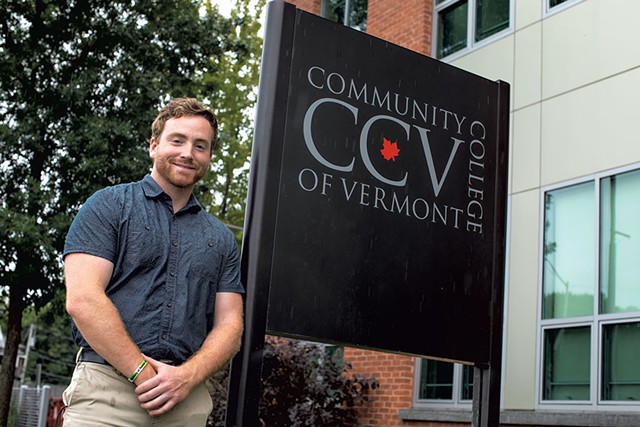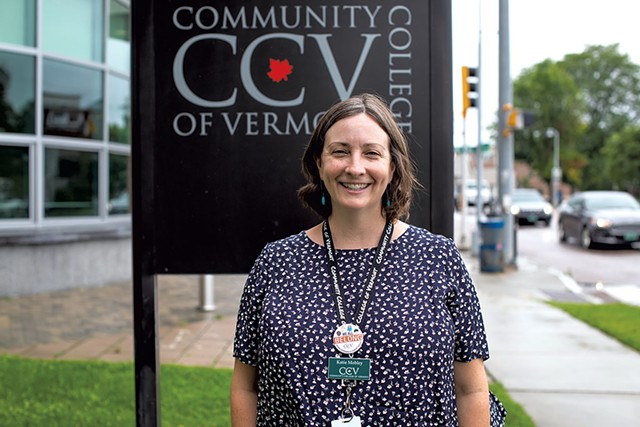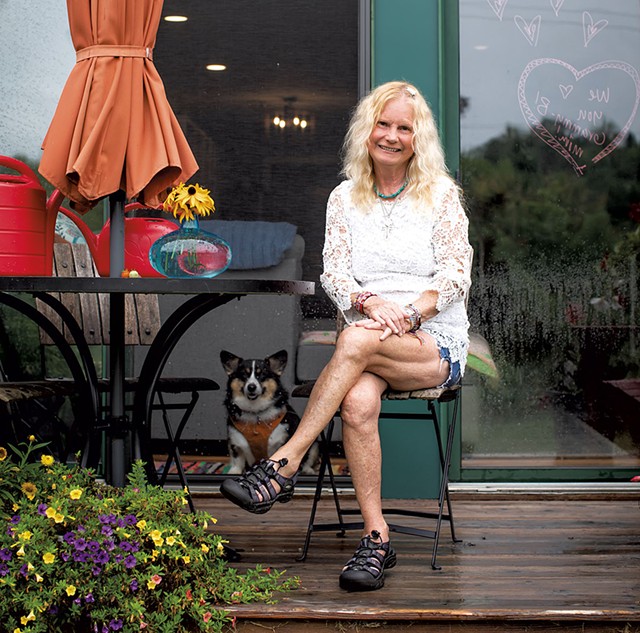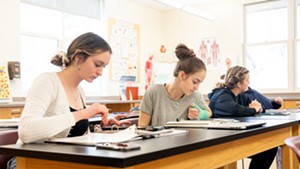
- Luke Awtry
- Quinn O'Reilly
For more than 30 years, Carley Stevens-McLaughlin worked full time as a photographer and high school teacher. When the COVID-19 pandemic hit, she decided to retire and seek a part-time job to supplement her social security income. But she found that options were limited for someone with her background, particularly during lockdown.
This fall, at age 63, Stevens-McLaughlin enrolled at Community College of Vermont to update her technology skills with graphic design courses. A state program that paid for two of her three classes gave her the final push to go back to school, she said.
"The world is changing," said Stevens-McLaughlin, who lives in Winooski not far from CCV's largest academic center. "I need professional development, and I need continued learning and skill building."
Stevens-McLaughlin was one of nearly 1,700 new students who had enrolled at CCV for the fall semester as of last Friday. That's a 40 percent increase over new student enrollment last year at the same time and even bests the pre-pandemic 2019 tally by 54 percent, according to the college's data.
As of Friday, the total number of enrolled students, including those returning to CCV, was 17 percent higher than on the same date in 2020 and 15 percent higher than in 2019. Approximately three-quarters of CCV students typically register in the next few weeks, just before classes start on September 6, so overall enrollment may far surpass that of previous years.
Katie Mobley, CCV's dean of enrollment and community relations, attributes the increase largely to new state financial assistance programs designed to make higher education more affordable to more Vermonters. Those programs — supported by federal pandemic-relief funds — include free classes or fully covered tuition for applicants who meet certain criteria.
"We got to say to these students, 'College is attainable. You can be successful,'" Mobley said. "It gave them the confidence to know they can do it."
Other Vermont colleges and universities are seeing similar spikes in enrollment this year compared to 2020. The University of Vermont, Champlain College, Middlebury College and Vermont Law School have experienced big jumps in the number of applicants and the size of incoming classes.
Enrollment at CCV, though, has remained steady since the pandemic began, even as its community college peers nationwide experienced significant declines in student numbers this past spring. Among an overall 3 percent drop in enrollment across all higher education, community college registration fell by 9.5 percent, according to the nonprofit National Student Clearinghouse Research Center, which collects and reports data on U.S. education and student outcomes. (Nationwide enrollment figures for the 2021 fall semester are not yet available.)

- Luke Awtry
- Katie Mobley
It's unclear why CCV has bucked that trend. Mobley touted its favorable reputation among a growing number of potential students. "The idea that CCV is a great place to start — we used to call that the best-kept secret in Vermont," Mobley said. "But I think the secret is getting out."
Across CCV's fall, spring and summer semesters each year, an average of about 10,000 students come through the school, and 93 percent are Vermont residents. They attend classes via 12 physical locations around the state and the college's online learning center.
CCV offers 11 associate's degrees and 22 certificate programs. Its courses cover a wide range of subjects, including the arts, biology, business management, computer science, criminal justice, economics, education, English and other languages, environmental science, health care, humanities, math, social sciences, and political science.
Even before the pandemic, 50 percent of the school's classes were offered solely online. That allowed a student near Bennington, where the CCV center is small and the course list more limited, for example, to access courses offered through other CCV locations, Mobley said.
Due to COVID-19 restrictions in the spring of 2020, CCV went fully remote, along with most colleges and universities. Now, based on fall course registrations, about one-quarter will take place in person, and the rest will be remote, Mobley said. About 80 percent of CCV's students go to school part time and have jobs or kids, so they embrace the flexibility of online learning, she added.
CCV is working to appeal to a broad swath of the population, Mobley said: "a high school junior who wants to take a dual-enrollment course; a woman who stays at home with the kids and wants to go back to work; someone who's worked a low-wage job for 10 years and is like, 'This isn't working. I need to do something else'; someone who's mid-career and says, 'I want to be an IT person.'"
Mobley said she hopes "that more and more people can see themselves here as successful CCV students."
At age 18, Quinn O'Reilly joined the military because he wasn't ready to jump into four years of college. After he completed his service with the U.S. Marine Corps in February 2020, O'Reilly returned home to Colchester and planned to study nursing.
Even then, the idea of sitting in a big lecture hall, where his professor would barely know his name, had no appeal. At CCV, he could get more personalized attention while completing the math, writing and other courses required to pursue a bachelor's degree, he said.
"I wanted to go somewhere where I can easily talk to my professor one-on-one, get the help I need," O'Reilly said.
That doesn't mean CCV lets students coast, O'Reilly added. His professors made sure he finished his first year prepared for the next step in his education.
"They put in a lot of work for their students, and they gave great feedback, timely feedback," O'Reilly said. "They gave you the tools to succeed. All I had to do was put in the work."
At the time, O'Reilly didn't realize that CCV worked closely with UVM to smooth the transfer process for students who want to pursue bachelor's degrees at the university. CCV offers 30 "transfer pathways" to UVM; the university makes scholarships available to students who have earned associate degrees at CCV and are continuing at UVM in the 2+2 Transfer Pathways Programs, Mobley said.
So, after a year at CCV, O'Reilly filled out the paperwork, and CCV administrators took care of the rest, he said. He starts next month at UVM's College of Nursing and Health Sciences.

- Luke Awtry
- Carley Stevens-McLaughlin
In spring 2020, soon after the COVID-19 pandemic set in, the Vermont-based J. Warren and Lois McClure Foundation paid for Vermont high schoolers who graduated in 2020 to take one CCV class for free. In that program alone, CCV enrolled 500 students last year, Mobley said, though many may have moved on to another institution after taking the single class.
The Vermont legislature stepped up this fall with the help of the private nonprofit Vermont Student Assistance Corporation, or VSAC, to replace the McClure offering with the Green Mountain Grad Gift. The program allows high schoolers graduating in 2020 or 2021 to take a free class at any school in the Vermont State Colleges System: CCV, Castleton University, Northern Vermont University or Vermont Technical College. It aims to give graduates a taste of college as they consider their future.
Other state scholarships and grants support students ready to commit to higher education. The Critical Occupations Scholarship provides free tuition to pursue studies in fields with high employment needs, such as childcare, health care, bookkeeping and information technology.
When combined with other federal and state money, the 802 Opportunity grant, a state legislative initiative in collaboration with VSAC, provides free tuition for CCV students whose family income is $50,000 or less. It covers two academic years for new and returning students, aiming to prepare them for desirable jobs and career advancement.
A program launched in mid-July was so popular that it filled up in just two days. The Upskill Vermont Scholarship Program channeled state pandemic-relief funding through UVM's Continuing and Distance Education for Vermonters to take free courses for professional development at UVM or CCV — whichever better fit students' needs. Nearly 500 people signed up. (Anyone still interested can join an email list for updates on future program offerings.)
Stevens-McLaughlin took advantage of a similar CCV workforce development program designed for Vermonters whose careers were curtailed by the pandemic. Those eligible can sign up for two free classes at any Vermont state college. CCV administrators worked with Stevens-McLaughlin to find alternate financial assistance for the third class she wanted to take this fall.
This is Stevens-McLaughlin's second turn at CCV; she earned her associate's degree there in the 1980s after an educational pause to raise her kids. She said she's grateful that CCV enables students like her — late in their careers but eager to learn more — to expand their opportunities. "They work really hard," she said, "to make it easy for people to attain their life dreams and goals."
Correction, August 25, 2021: An earlier version of this story mischaracterized the 30 transfer pathways from CCV to UVM.










Comments
Comments are closed.
From 2014-2020, Seven Days allowed readers to comment on all stories posted on our website. While we've appreciated the suggestions and insights, right now Seven Days is prioritizing our core mission — producing high-quality, responsible local journalism — over moderating online debates between readers.
To criticize, correct or praise our reporting, please send us a letter to the editor or send us a tip. We’ll check it out and report the results.
Online comments may return when we have better tech tools for managing them. Thanks for reading.